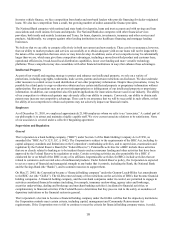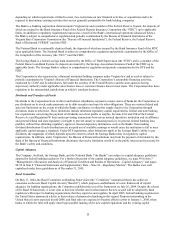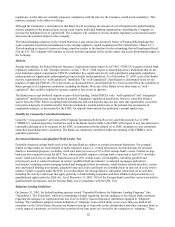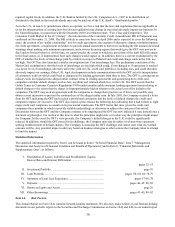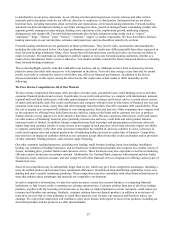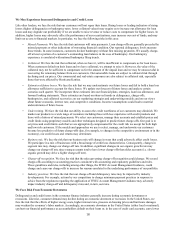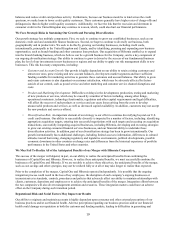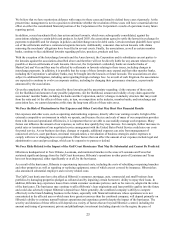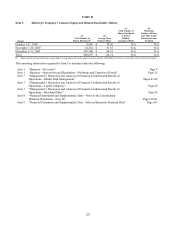Capital One 2005 Annual Report Download - page 24
Download and view the complete annual report
Please find page 24 of the 2005 Capital One annual report below. You can navigate through the pages in the report by either clicking on the pages listed below, or by using the keyword search tool below to find specific information within the annual report.require verification of customer identification; and require financial institutions to have in place an anti-money laundering
rogram. p
In
terstate Taxation
Several states have passed legislation which attempts to tax the income from interstate financial activities, including credit
cards, derived from accounts held by local state residents. Based on the volume of our business in these states and the nature
f the legislation passed to date, we currently believe that this development will not materially affect our financial condition. o
Legislation
Legislation has been enacted requiring additional disclosures for credit cards and other types of consumer lending. Such
legislation places additional restrictions on the practices of credit card issuers and consumer lenders generally. In addition to
the FCRA and FACT Act provisions discussed above, Congress has enacted broad changes to the federal Bankruptcy code,
including a sweeping reform of the consumer bankruptcy provisions which, while instituting a means test for individuals
filing under chapter 13 and enacting other reforms, also requires credit card issuers to provide regular disclosures to
customers of the financial effect of regularly making only the minimum required payment on their accounts. Additionally,
deposit insurance reform legislation has just been enacted and must now be implemented by the FDIC. Also, proposals have
been made to restrict certain consumer lending practices and expand the privacy protections afforded to customers of
financial institutions. It is unclear at this time whether and in what form any legislation will be adopted or, if adopted, what
its impact on the Bank, the Savings Bank, the National Bank, COAF or the Corporation would be. Congress or individual
states may in the future consider other legislation that would materially and/or adversely affect the banking or consumer
nding industries.
le
S
arbanes-Oxley Act Compliance
On July 30, 2002, the Sarbanes-Oxley Act of 2002 (the “Sarbanes-Oxley Act”) was passed into law. The Sarbanes-Oxley Act
applies to all companies that are required to file periodic reports with the Securities and Exchange Commission (“SEC”) and
contains a number of significant changes relating to the responsibilities of directors and officers and reporting and
governance obligations of SEC reporting companies. In addition, the Sarbanes-Oxley Act also created the Public Company
Accounting Oversight Board (the “PCAOB”), a private sector, non-profit corporation whose mission is to oversee the
auditors of public companies. The PCAOB recommends rulemaking to the SEC and sets certain standards for the auditors
which it oversees. Since the passage of the Sarbanes-Oxley Act, the Company has taken a variety of steps which it believes
place it in substantial compliance with the effective provisions of the Sarbanes-Oxley Act. The Company continues to
monitor SEC rulemaking and PCAOB activities to determine if additional changes are needed to comply with provisions that
may become effective in the future. Furthermore, the Company’ s management has supervised the design of, or has designed,
internal controls and procedures to provide reasonable assurances regarding the reliability of its financial reporting and
disclosure controls and procedures to ensure that material information regarding the Company is made known to them,
particularly during the period in which this Annual Report on Form 10-K is being prepared and has evaluated the
effectiveness of those controls as more fully set forth in “Controls and Procedures” below. The Company has, in compliance
with Section 404 of the Sarbanes-Oxley Act, certified, in connection with this Annual Report on Form 10-K, that it did not
discover, during the execution of its internal control processes, any material weaknesses. Management’ s assessment of the
effectiveness of internal control over financial reporting excludes the evaluation of the internal controls over financial
reporting of Hibernia Corporation and its subsidiaries, which were acquired on November 16, 2005. In addition, the
Company’ s management policy is to disclose to the Company’ s auditors and the Audit and Risk Committee of the Board of
Directors significant deficiencies, if any, in the design or operation of its internal control over financial reporting, which are
reasonably likely to adversely affect the Company’ s ability to record, process, summarize and report financial information, as
well as any fraud, whether or not material, by those that have a significant role in these processes.
International Regulation
The Bank also faces regulation in foreign jurisdictions where it currently, and may in the future, operate. Those regulations
may be similar to or substantially different from the regulatory requirements the Bank faces in the United States. In the
United Kingdom, the Bank operates through the U.K. Bank, which was established in 2000. The U.K. Bank is regulated by
the Financial Services Authority (“FSA”) and licensed by the Office of Fair Trading (“OFT”). The U.K. Bank is an
“authorized deposit taker” and thus is able to take consumer deposits in the U.K. The U.K. Bank has also been granted a full
license by the OFT to issue consumer credit under the U.K.’ s Consumer Credit Act—1974. The FSA requires the U.K. Bank
to maintain certain regulatory capital ratios at all times. The U.K. Bank obtains capital through earnings or through additional
capital infusion from the Bank, subject to approval under Regulation K of the rules administered by the Federal Reserve. If
the U.K. Bank is unable to generate sufficient capital in favorable terms, it may choose to restrict its growth to maintain its
15







